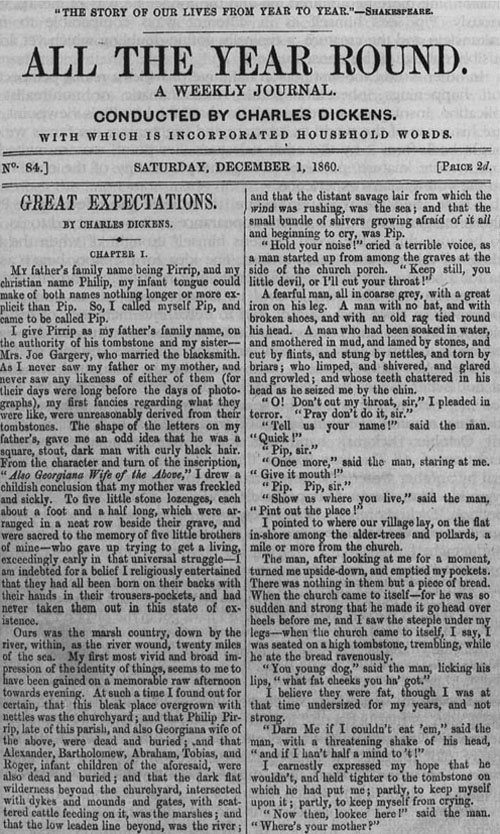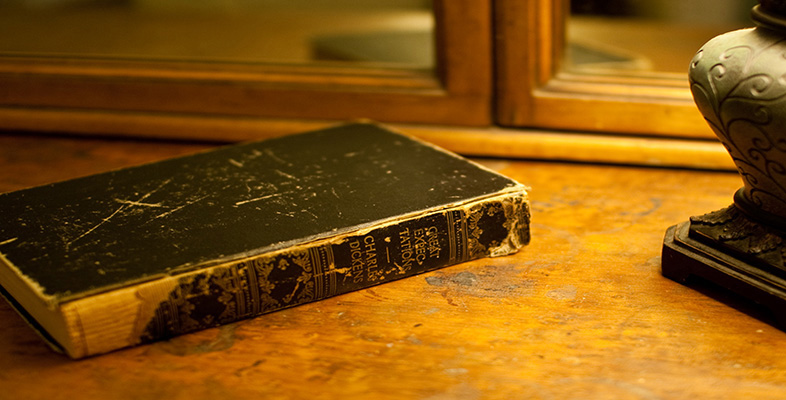1.3 The serialised novel
That Dickens knew of Shelley's creature and may well have had him in mind is indicated by an explicit association very much later, after Pip finally learns the identity of his mysterious benefactor. He thinks of himself in the role of the ‘imaginary student pursued by the misshapen creature he had impiously made, [who] was not more wretched than I, pursued by the creature who had made me, and recoiling from him with a stronger repulsion, the more he admired me and the fonder he was of me’ (p.335). Curiously, Pip sees himself as in different ways comparable to both Frankenstein and the creature, a typically gothic doubling which yet arises plausibly enough in his consciousness.
In other words, the first person narrative provides a realist perspective upon happenings inherently gothic, melodramatic or non-realist in implication. Insofar as we are brought to share the boy Pip's viewpoint, we share his sense of the world as arbitrary and frightening; insofar as we are brought back from it by the adult narrator's viewpoint, we are invited to adopt a more ‘mature’ position, noting the plausibility of the child's and then the young man's experience.
I have used the word ‘grotesque’ to indicate the effect upon Pip's childish imaginings of the convict's appearance as it is conveyed to us, but also because this is the word Dickens himself thought of when the first inklings of this narrative came to him. The idea for the story began as an idea for a short essay by a semi-fictional adult narrator he had created for his magazine All The Year Round in January 1860, to recount recent experiences in town and country, and to delve into memories of his own childhood in Kent and London. As Dickens began to compose the essay, there came to him ‘a very fine, new, and grotesque idea’, he told his friend and biographer John Forster. ‘I begin to doubt’, he continued, ‘whether I had not better cancel the little paper, and reserve the notion for a new book … I can see the whole of a serial revolving on it, in a most singular and comic manner’ (Forster, Life of Charles Dickens, 1928 edn, p.733). By early October Dickens's hand was forced by the need to boost the circulation of All The Year Round, then falling as the result of a tedious serial by another writer. The new serial was to concern the adventures of ‘a boy-child, like David [Copperfield]’ and, to avoid any unconscious repetition, Dickens reread David Copperfield and was ‘affected by it to a degree you would hardly believe’. His approach to the new serial was to be more detached:
I have made the opening, I hope, in its general effect exceedingly droll. I have put a child and a good-natured foolish man, in relations that seem to me very funny. Of course I have got in the pivot on which the story will turn too – and which indeed, as you remember, was the grotesque tragicomic conception that first encouraged me.
The ‘very funny’ relationship between the child and the ‘good-natured foolish man’ is that between Pip and his sister's husband, Joe Gargery the blacksmith. The ‘grotesque tragi-comic conception’ upon which the whole mystery plot turns is, of course, the connection between Pip and the convict. The terms Dickens uses suggest popular theatrical or romance conventions, according to which distant or long-lost relations turn up when they can cause most surprise. Dickens had already published Hard Times as a serial to revive the fortunes of All The Year Round's predecessor, Household Words, a twopenny weekly begun in 1850 with the aim of casting ‘something of romantic fancy’ over ‘familiar things’ (ibid., p.512). When he hastily decided to put his new idea into All The Year Round, which had already seen the heartening effect upon sales of his historical romance, A Tale of Two Cities (1859), he planned a weekly serial of about the same length. It was to be much shorter than his other novels, normally published in twenty monthly parts, but would still be read over a lengthy period of time (Figure 2).

Activity 3
Like all Dickens's serializations, Great Expectations was also published in book form (in three volumes) shortly after its completion in the magazine. When speaking of serialization, he told an aspiring author: ‘There must be a special design to overcome that specially trying mode of production’ (Paroissien, Selected Letters of Charles Dickens, 1985, p.318, 20 February 1866). What do you think the fact of this magazine serial mode of production implies in terms of the author's relationship with his readers and with the characters and plot of the novel?
Discussion
The most obvious effect is that it helps the author-narrator, that is, the adult narrator not the boy Pip, seem close to his readers. We are likely to identify with him, to share his vision and judgements, and it may be difficult to realise that he is, after all, a fictional construct as much as the boy Pip. The serial mode of publishing fiction is bound to build up a powerful illusion of reality. However fanciful the treatment, we are likely to identify closely with a character or voice met repeatedly over an extended period of time, as in a television ‘soap opera’. In first person narrative, that character is the narrator.
If we are likely to identify sympathetically with characters we feel we come to know over time, we also need certain memorable features established and repeated to hold a long and complicated narrative in our minds. Dickens famously created a profusion of characters for his big novels, characters vividly defined so that they needed no reintroduction. Although there are fewer characters in Great Expectations, they exhibit distinctive verbal and/or physical mannerisms to keep them in the reader's mind. One of the most notable among the convict's mannerisms in the early chapters is a ‘click’ in the throat when his more sympathetic feelings are aroused (p.19), a little detail that recurs very much later (pp.316, 442). Another example of a memorable feature might be Mrs Joe's reputation for bringing her younger brother up ‘by hand’ (p.8), repeated whenever she appears in the earlier part of the book.
The relative brevity of Great Expectations meant that it required very tight control over the narrative plotting, including a note of suspense at the end of each weekly episode of one or two chapters, whereas for his other novels Dickens could afford a more leisurely pace.(The serialization plan for Great Expectations is given as Appendix C on page 487 of the 1994 edition of the novel cited throughout this chapter.) The three volumes of the book coincide with the three distinct and roughly equal parts of the plot. The first deals with Pip's childhood in Kent and the dissatisfactions set up by Satis House; the second with his life as a young ‘gentleman’ in and around Little Britain in London; and the third with the arrival of the convict, and Pip's attempts to save him, to forgive Miss Havisham and to be forgiven by Joe.
